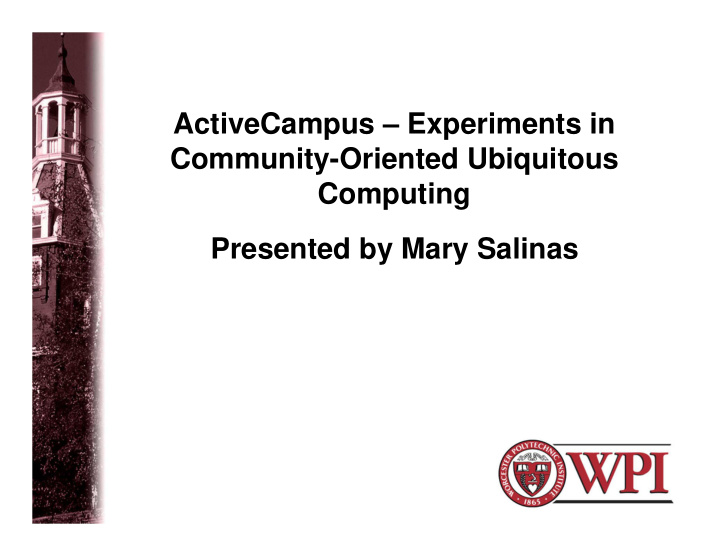



ActiveCampus – Experiments in Community-Oriented Ubiquitous Computing Presented by Mary Salinas
What did they do? • Created two software components: ActiveClass and ActiveCampus. • Distributed HP Journada Pocket PC PDAs to 3 classes and 300 freshmen to use with software. • Encouraged students to use them to interact with instructor and students in class. • Encouraged students to use them in informal interactions with each other. 2 Worcester Polytechnic Institute
Why did they do it? • Wanted to study use of handhelds in a way that would enrich the experience of college life. • Answer questions about what sort of applications, infrastructure and interfaces would make handhelds fulfill promise. • Using technology that would provide 3 value from fellow users Worcester Polytechnic Institute
Implementation • Client/server model with server including a web server with MySQL and PHP. • Applications served with HTML • SOAP RPC calls handle location detection and reporting. 4 Worcester Polytechnic Institute
ActiveClass Functionality • Could ask a question • Questions could be answered by others • Questions could be voted on to encourage professor attention 5 Worcester Polytechnic Institute
ActiveClass • Designed for use in large class where often students do not interact much with professor. • Acted as a “virtual student”. • Identity of student is hidden from other students but is available to professor of the class. 6 Worcester Polytechnic Institute
ActiveClass Results • 1/3 of students used it regularly. Majority did not. • Professor felt it was a success and would use again. • Students found it hard to use phones in addition to taking notes. • Students frequently answered each others questions . 7 Worcester Polytechnic Institute
ActiveCampus Views 8 Worcester Polytechnic Institute
ActiveCampus Functionality • Main screen includes showing location, activities and Buddies on map. • Buddies list is organized by proximity to user with location displayed. • Other pages show list of locations, list of graffiti, and can do actions to them. 9 Worcester Polytechnic Institute
ActiveCampus Limitations • Limited PDA battery life and constant use model was serious limitation. • Graffiti was not displayed on maps and thus not obvious. • Users had difficulty keeping phones where they could be used. Women’s clothing does not provide pockets for storage. 10 Worcester Polytechnic Institute
ActiveCampus Postive Results • Users did seem to use it more frequently for people nearby. • People did not seem concerned about their location and only 1% hid it completely. 8.2% revealed location to non-buddies. • Suggested that relative location might be very useful. 11 Worcester Polytechnic Institute
ActiveCampus – Participation over Time 12 Worcester Polytechnic Institute
What has happened since then? • Two separate areas really. One is location-awareness and social applications. • Foursquare (2009) and other location- aware applications exist now. • Also follow-up work in many places on improving classroom interactions 13 Worcester Polytechnic Institute
Other work in classroom environment? 2007 - Exploring the Potential of Mobile Phones for Active Learning in the Classroom http://cseweb.ucsd.edu/users/wgg/Abs tracts/fp142-lindquist.pdf Discusses SMS, MMS interaction in class as well as tablets. Too costly for many 14 Worcester Polytechnic Institute
Any Questions? 15 Worcester Polytechnic Institute
Recommend
More recommend